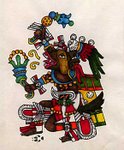Not unlike the injunction of El Salvador’s St. Oscar Romero who addressing the military and paramilitary of the fascist government said: No soldier is obligated to obey a law that goes against God's law, because no one has to obey an immoral law.
The fascist U.S. President Trump immediately responded by accusing them of being traitors guilty of “seditious behavior, punishable by death.”
Trump (like his minions in his administration) knows nothing of, nor could care less about the law and the Constitution he swore to “preserve, protect and defend." It is unlikely that lightning will strike him. The six Congress members took the same oath and take it seriously. (I took the same oath when I joined the U.S. Navy 71 years ago and, like them, take it just as binding.)
This night of the full moon on St. Barbara’s feast, I find her legend timely.
Este tanka en la fiesta de Santa Bárbara va dedicado a Jason Crow, Chris Deluzio, Maggie Goodlander, Chrissy Houlahan, Mark Kelly, Elissa Slotkin del Congreso de los EE. UU., tod@s veteran@s, quienes dirigiéndose al ejército estadounidense dijeron: Sabemos que están bajo enorme estrés y presión en este momento. Los estadounidenses confían en sus militares. Pero esa confianza está en riesgo. Esta administración está enfrentando a nuestros militares uniformados y profesionales de la comunidad de inteligencia contra los ciudadanos estadounidenses. Al igual que nosotros, todos ustedes juraron proteger y defender esta Constitución. En este momento, las amenazas a nuestra Constitución no solo provienen del extranjero, sino de aquí mismo en casa. Nuestras leyes son claras. Pueden rechazar órdenes ilegales. Pueden rechazar órdenes ilegales. Deben rechazar órdenes ilegales. Nadie tiene que cumplir órdenes que violen la ley o nuestra Constitución. Sabemos que esto es difícil y que es un momento difícil para ser un servidor público. Pero ya sea que presten servicio en la CIA, el Ejército, nuestra Marina Armada o la Fuerza Aérea, su vigilancia es fundamental. Y sepan que los respaldamos. Porque ahora más que nunca, el pueblo estadounidense los necesita. Necesitamos que defiendan nuestras leyes, nuestra Constitución y nuestra identidad como estadounidenses.
No distinto al encargo de San Óscar Romero de El Salvador, quien, dirigiéndose a los militares y paramilitares del gobierno fascista, dijo: Ningún soldado está obligado a obedecer una ley que contradiga la ley de Dios, porque nadie tiene que obedecer una ley inmoral.
El presidente fascista estadounidense, Trump, respondió de inmediato acusándoles de traidores, culpables de "comportamiento sedicioso, castigado con la muerte".
Trump (al igual que sus esbirros en su administración) desconoce y no le importa en absoluto la ley y la Constitución que juró "preservar, proteger y defender". Es improbable que le caiga un rayo. Los seis congresistas hicieron el mismo juramento y lo toman en serio. (Yo hice el mismo juramento cuando me uní a la Marina de los Estados Unidos hace 71 años y, como ellos, lo considero igualmente obligatorio).
Esta noche de luna llena en la fiesta de Santa Bárbara, encuentro su leyenda oportuna.































